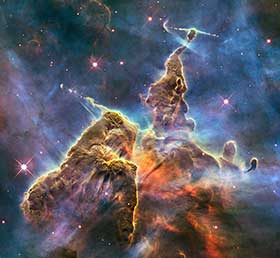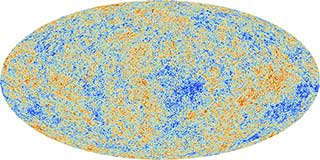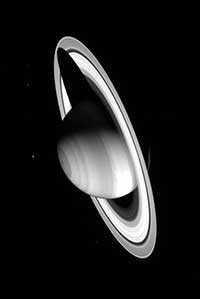
Light on the Dark Side: Images
and Reflections from Outer Space
- Phil MacGregor
_______________________________

Fig. 1. The Carina Nebula, 2010 

Fig. 2. Image of the Early Universe, 2013 

Imagery from outer space has been coming at us from all directions over recent decades. Elizabeth Kessler [1] estimates the Hubble space photos have seen the greatest diffusion of all scientific images into popular hands — maybe of all time. The media, including television and print newspapers, have been important in their distribution, but, increasingly, imagery of space has been coming to audiences through online channels. The theme of this paper is a reflection on website representation of visual aspects of the enculturation of what is called space, the region beyond the atmosphere of planet earth.
A study of online media is timely since attention to scientific representation in news media has until now mostly covered print formats. Online communication gives scope for changes in several dimensions, such as the inclusion of multimedia, changes in frequency of publication, more audience interaction, the display of reader comments and conversations, sharing on social media, and a range of potentials including unrestricted quantities of visual and verbal content. The news values — the criteria for inclusion of content on a webpage — of space coverage have not recently been studied.
This discussion is based on output from four websites, from which the images and texts are all taken: The Guardian online space section (UK), Le Figaro's science section (France), the space section of the New York Times, and the blog by the science editor of NBC, called Cosmic Log (U.S.). All the sites were intermittently tracked over 24 months from July 2011 recording screenshots of text, images, multimedia, and headlines. Space images and debates are growing in public appeal. Space stories can be the most popular of any topic of the day, outstripping sport and politics according to the chief science editor of the German newspaper Die Welt (2013; interview with author).
What kind of images are we talking about? Sometimes pictures on the sites are of astronauts; very often they are of rockets and gadgets in space (much the most numerous), or they focus on non-human scientific events and conditions, like the atmospheres or surfaces of celestial bodies. They include pictures of distant phenomena in space of interest to astrophysicists answering questions on the origin and fate of the universe. Among these are beautiful pictures (fig. 1) and also plainer images (fig. 2), such as conditions after the big bang that are highly newsworthy because they tell of an important adjustment of scientific understanding. There are also attractive images of planets inside the solar system (fig. 3) that interest planetary scientists rather than astrophysicists. The images are often linked to narratives of discovery as revealed in accompanying text. It is a feature of space imagery that it is very dependent on explanatory text. Nearly all fall under a positive trope of epic human activities.
The focus on newspaper website representations allows a comparison with interpretations of news photography and journalism in the pre-Internet era of print. How have digital presentations changed things — are we still concerned with journalistic photographs as bearing the signs of objectivity, truth-telling, or evidence? Do the selection criteria for images and video used online mirror past definitions of news values given for science by Nelkin [2] or Hansen [3]? These authors list several factors that make news in science, such as human angle, relevance to everyday life, accessibility, proximity, controversy, breakthrough, and weird and wacky. As Hansen says, many of them mirror established newsworthiness criteria found in general news, such as cultural fit, event magnitude, proximity, unambiguity, reference to elite people/nations, relevance, consonance, and predictability, as first suggested by Galtung and Ruge. [4] Nelkin (Ibid.) comments on the breakthrough euphoria that infected the reporting tone of the 1960s linked to space exploration, and although it gave way to disillusion for a while, the notion of “breakthrough” has often been noted as a key driver for science inclusion in news.
Do space images move the boundaries and challenge the rough uniformity seen in decision-making practices of news? The web, after all, is another “organizational arrangement” for science presentation in media in the same way as newspaper sections devoted to science allowed considerably more flexibility than news sections, as noted by Hansen (Ibid.). The online medium offers even more scope to show content, and journalists are less bounded by time deadlines.
It's worth bearing in mind that one constriction on extra-terrestrial reporting derives from the fact that almost all space imagery is supplied by outside sources. News people rarely take their own space photos, unless they are easily observed, like meteor strikes or nearby eclipses. The reliance on scientific image sources like the cameras on the space probe Curiosity in 2013 structure space science journalists more into the game of relay than of originators, since there is a self-evident removal of the journalistic power of witness for much of outer space. Anyway, science reporting has always been dependent on expert sources and science writers exercise their professionalism mostly in terms of judging their validity (Hansen, Ibid.).
Science and Journalism
The relationship of science and journalism, and the interpretive functions of the institution of journalism are hugely complex. In part they may be said to revolve around a series of journalistic tenets including the commitment to accuracy, completeness, and balanced content selection. Accuracy includes the act of transference from one set of terminologies to another, or the transference of complex physics and biology into metaphors of non-scientific discourse and everyday experience. Completeness refers to the extent of coverage of potential scientific topics. One approach to judge this aspect is to look at science sources for comparison. If one uses the source arXiv.org that lists many topical astronomical and pure physics journal reviewed articles, it isn't difficult to show that the overwhelming majority of journal papers to do with astrophysics and astronomy are ignored by media.
As well as their output lacking faith to true science as conceived by scientists [5], journalists are sometimes accused of negativity and as being “an opaque lens unable to present and filter scientific content properly,” which is said to have contributed in the past to the scientific illiteracy of the public. There is a large literature on the negative aspects of the coverage of science. Nelkin (Op. cit.) calls journalists and scientists “wary collaborators in the business of science communication,” even if mutually dependent. She accuses the media of paying scant attention to the substance of scientific arguments, or its slow accumulative processes, or the limits of its theories. All of this, she says, “helps perpetuate the distance between science and citizen.” Schnabel [6] points to a contrary narrative in media whereby science is uncritically idealized as an ultimate authority, a theme explored also by Broks [7]. There are also more positive impressions of the role of media, such as that it conducts a pivotal and complex act of mediation for public understanding and for scientists themselves to further their research (Bucchi and Mazzolini, Ibid., Broks Ibid.).
[1] Elizabeth Kessler, Picturing the Cosmos: Hubble Space Telescope Images and the Astronomical Sublime, Minneapolis, London, 2014, University of Minnesota Press, 2014.
[2] Dorothy Nelkin, Selling Science: How the Press Covers Science and Technology, New York, Freeman Press, 1987.
[3] Anders Hansen, “Journalistic Practices and Science Reporting in the British Press” (1994) Public Understanding of Science, Vol. 3 N° 2, pp. 111-134.
[4] Johan Galtung and Marie Holmboe Ruge, “The Structure of Foreign News. The Presentation of the Congo, Cuba and Cyprus Crises in Four Norwegian Newspapers,” Journal of Peace Research, Vol. 2. N° 1, 1964, pp. 64-91.
[5] Massimiano Bucchi and Renato Mazzolini, “Big Science, Little News: Science Coverage in the Italian Daily Press, 1946-1997,” Public Understanding of Science, 2003, pp. 7-24.
[6] Ulrich Schnabel, “God’s Formula and Devil’s Contribution: Science in the Press,” Public Understanding of Science, N° 12, 2003, pp. 255-259.
[7] Peter Broks, Understanding Popular Science, Maidenhead, Open University Press, 2006.


